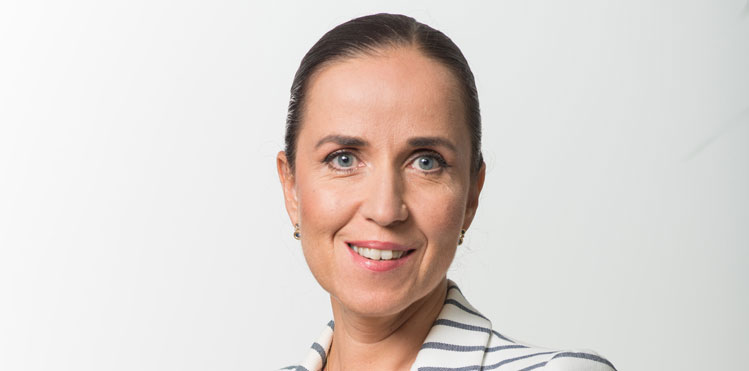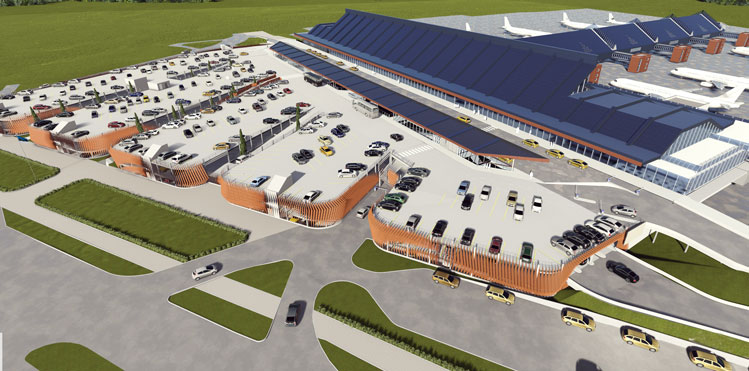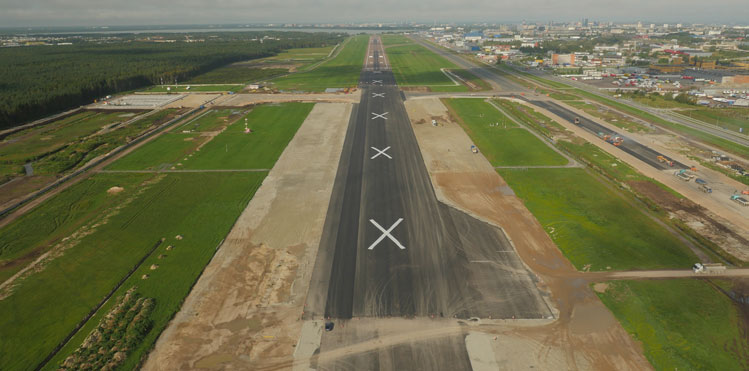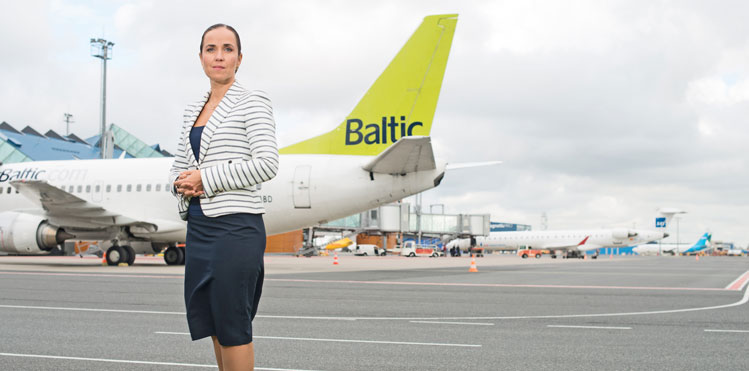Piret Mürk-Dubout, CEO Lennart Meri Tallinn Airport, interviewed by Ross Falconer.
Tallinn is often referred to as the “Silicon Valley of Europe”. Estonia’s alluring capital city has a population of 440,000 (about a third of the country’s 1.4m total) and is home to the highest number of start-ups per capita in Europe. Most famously, it is the birthplace of Skype, while other notable Tallinn start-ups include TransferWise (a peer-to-peer money transfer service, which has attracted investment from the likes of Sir Richard Branson) and Pipedrive (a cloud-based sales software company). The city is a hotbed of entrepreneurship and innovation, which is mirrored by the airport’s progressive approach.

Piret Mürk-Dubout, CEO Lennart Meri Tallinn Airport: “In a way we are a calling card for Estonia and our aim is to be ‘the cosiest airport in the world’. This slogan also serves as our customer promise and we work hard to achieve this at every contact point with our customers and partners.”
Piret Mürk-Dubout was appointed as the new CEO of Lennart Meri Tallinn Airport in June and officially started in the role at the end of August. Her background is in telecommunications and IT services, including senior management positions within Eesti Telekom Group in Estonia and abroad, and she draws parallels with the airports industry such as heavy global competition and the importance of agility and innovation in business development. “The company’s development plans are set and major investments require skilful management, but I also believe that my prior international work experience will definitely create many opportunities for the development of the airport,” she adds.
Speaking to Airport Business just a month into her tenure, Mürk-Dubout explains that “these past few weeks have been mostly about getting to know the people and the organisation at Tallinn Airport, and its community”. “There are a number of major infrastructure development projects in motion, with the aim to improve the customer experience and provide a bigger variety of business and operational opportunities to our partners.”
Indeed, Mürk-Dubout has joined at an exciting time for the airport, which is celebrating its 80th anniversary this year, investing €120 million in infrastructure developments, and preparing for Estonia hosting the EU Presidency in the second half of 2017.
“Customer engagement via social media”
Tallinn Airport has been preparing for its 80th anniversary for quite some time, with the anniversary theme incorporated into its customer dialogue and brand messages throughout the year. The airport has a proactive digital communications strategy and is active on social media, with over 17,000 Facebook ‘likes’ and almost 1,000 followers on Twitter. Estonia has declared internet access a human right, and it has digitally streamlined an unprecedented number of public services for citizens and businesses. Tallinn Airport is embracing the countrywide enthusiasm for e-services, and unlimited free WiFi is central to its proposition for passengers. Its latest digital innovation is the ability to pay for parking via mobile device at any of the airport’s car parks.
“We have launched special customer engagement via social media and dedicated historic web-reviews about the history and development of Tallinn Airport,” Mürk-Dubout explains. “The culmination of these events occurred at the end of September with formal celebrations for our customers, partners and employees, and of course, the Estonian society at large as well. But we don’t like to focus too much on looking back at this time – as we are in the process of major extension works, we like to keep our sights on the challenging future instead.”
Tallinn Airport’s myriad developments are taking place against the backdrop of consistent growth, which saw it handle 2.2 million passengers in 2015 – up 7.4% year-on-year, and building on 3% growth the previous year. Figures for the first six months of 2016 show a 1% increase to 1.02 million passengers.
Air traffic restrictions are in place to ensure safety in the construction zone, while the airport undertakes its infrastructure developments, so the aim is to match last year’s traffic volumes in 2016.
The airport is maintaining that consistency this year, despite the demise of national carrier Estonian Air last November, which operated 27% of Tallinn Airport’s services. Several carriers, including airBaltic, easyJet and SAS, quickly stepped in to replace the lost capacity. The Estonian Government also responded by creating a new carrier – Nordica – which currently operates using the AOC of Adria Airways and is now Tallinn Airport’s biggest airline. Nordica serves 15 destinations from Tallinn, most recently launching services to Rijeka in June and to Odessa in May.
“Our investment programme keeps a strong focus on improving and increasing capacity to prepare ourselves for larger growth numbers in the future,” Mürk-Dubout notes.
€120m investment programme

Tallinn Airport’s €120 million investment over the next four years includes a new car park with capacity for 1,200 vehicles. The airport’s latest digital innovation is the ability to pay for parking via mobile device at any of the airport’s car parks.
The €120 million investment over the next four years involves redevelopment of the airside area, expansion of the passenger terminal, and a new car park with capacity for 1,200 vehicles.
“Reconstruction of the airside area is one of the largest recent construction projects in Estonia, because in addition to the construction work, we must also ensure flight safety and the regular functioning of the flight operations,” Mürk-Dubout comments. “We have applied certain night-time restrictions to air traffic in the summer months, but thanks to the cooperation and understanding between the airport, the builders and the airlines, we have managed to avoid major disruption to our normal schedule. This is a sign of the professionalism, commitment and good cooperation our people demonstrate on a daily basis in everything that they do.”
Extension of the airside area is progressing apace. Tallinn Airport is currently extending the runway from 3,070m to 3,480m, while next year will see resurfacing works, replacement of the airfield lighting with a new energy-efficient solution, and a more advanced navigation solution installed.
Estonia, like its Nordic and Baltic neighbours, is also a beacon of environmental innovation. Tallinn Airport is itself accredited at Level 1 Mapping of ACI’s Airport Carbon Accreditation, and environmental considerations are at the heart of its infrastructure developments. As part of its airside extension, an additional de-icing area will be built at the east side of the airport, alongside environmentally-compliant snow melting sites, melted snow discharge and monitoring systems, and an aircraft engine testing area. Mürk-Dubout explains that the aim is to enhance the environmentally sustainable and efficient management of the airport. Key long-term environmental objectives include increasing the use of renewable energy, reducing waste generation, increasing waste recycling, and reducing both carbon emissions and water use.

Extension of the airside area is progressing apace. Tallinn Airport is currently extending the runway from 3,070m to 3,480m, while next year will see resurfacing works, replacement of the airfield lighting with a new energy-efficient solution, and a more advanced navigation solution installed.
‘The cosiest airport in the world’
The passenger terminal will be extended to accommodate a larger security control area and additional VIP rooms for the EU Presidency. Meanwhile, the new car park will be completed after 2018. “Another important development will be connecting the terminal with the tramway, linking the airport with the city centre through urban passenger transport. After all, we are only 4km from the city centre – a rare feat in Europe these days,” Mürk-Dubout enthuses.
The airport, of course, plays a pivotal role in welcoming visitors to Estonia, as the first impression and last memory of the country. “In a way we are a calling card for Estonia and our aim is to be ‘the cosiest airport in the world’,” Mürk-Dubout says. “This slogan also serves as our customer promise and we work hard to achieve this at every contact point with our customers and partners.”
The initial plan was to complete the major terminal developments by the end of 2017, just in time for Tallinn Airport to host guests during Estonia’s EU Presidency. Following the Brexit vote in June, the UK gave up its six-month rotating EU Presidency, shifting the timetable and bringing Estonia’s EU Presidency forward by six months. “We are under some pressure to complete some of the works in time to welcome our distinguished guests, but with hard work and meticulous planning we will be able to deliver what is expected from us during these challenging times,” Mürk-Dubout comments.
Tallinn’s tourism magnet: 4.3m overseas visitors
As well as being the tech-savvy home of many innovative start-up companies, Tallinn is increasingly a tourism magnet – its Old Town being a UNESCO World Heritage site, and there are hundreds of kilometres of untouched nature to explore. 4.3 million overseas tourists visited Tallinn in 2015. 45% (1.9m) of these were from Finland, 9% (390,000) from Russia, 7% (297,000) from Germany, 5% (223,000) from the US, and 5% (204,000) from Asia.
Tallinn Airport works hand-in-hand with the Estonian Tourist Board, Enterprise Estonia, relevant ministries and trade associations to determine the most optimal route density and geographical spread for a country of Estonia’s size and location.
“We have identified certain industry players with whom we are in constant contact and we aim to incentivise them to increase their network from Estonia,” Mürk-Dubout explains. “We are very pleased with our current mix of airlines – we have a healthy combination of legacy and low-cost carriers, and the six largest airlines enjoy an almost equal market share between them. It is a well-diversified portfolio and we cover most of the hubs that are important to Estonian business and leisure travellers. More importantly, however, we keep a close eye on all routes that bring in traffic from elsewhere. Our primary focus will always be on Europe, but we do see some potential in transfer routes between the immediate east and the west as well.”

Piret Mürk-Dubout, CEO Lennart Meri Tallinn Airport: “Airport operations and business development cannot be considered a local business, and opportunities to create more value to the local economy are huge. I really look forward to working together with Tallinn Airport’s dedicated and professional team in order to meet great new business challenges.”
Regional airports
Tallinn Airport manages four regional Estonian airports: Tartu, Pärnu, Kuressaare, and Kärdla. Tartu is the only regional airport with a scheduled international service – Finnair to Helsinki. It handled 21,000 passengers in 2015 and reported impressive 72% growth in the first half of 2016, with almost 14,000 passengers. Pärnu Airport handled 2,000 passengers in 2015, Kuressaare handled 14,500 passengers, and Kärdla handled 8,000 passengers.
Having carefully analysed the current market situation, the airport has identified some key routes that it would like to see better served in the future. These include London and other UK destinations, Germany, and some Spanish destinations for the leisure market. A key goal is harmonisation of the seasonal schedules – there are currently over 20 destinations served in winter and over 30 in summer.
Mürk-Dubout speaks enthusiastically about the efforts of Tallinn Airport’s aviation marketing team in collaborating with airlines to promote new services, and ensure every new route is “heard and talked about in Estonia”. “We love crazy, outside-the-box ideas.” This may take the form of joint inaugural events with airlines, marketing campaigns to celebrate new routes, PR support, or close cooperation with local tourism authorities.
These myriad developments at Tallinn Airport are truly facilitating the development of Estonia’s business and tourism, thereby increasing the country’s competitiveness.
“Our ambition is to receive even higher satisfaction results from our customers and partners,” Mürk-Dubout concludes. “The priorities have been set – everyone’s attention is turned to delivering the construction projects on time and with assured quality. We need to focus on route development for next year based on our strategic goals, and we are very excited about the challenges the EU Presidency will bring us next year.”
Tallinn Airport factbox
2015: 2.2 million passengers
2015 passenger traffic growth: 7.4%
2016 passenger traffic growth (Jan-Aug): 0.2%
Key airline customers: airBaltic, Finnair, Lufthansa, Nordica, Ryanair, SAS
Number of routes:
30+ (summer season)
20+ (winter season)
Top 5 destinations: Frankfurt, Helsinki, Riga, Oslo, Stockholm
Piret Mürk-Dubout curriculum vitae
Piret Mürk-Dubout (46) was born in Viljandi, Estonia. She studied law and journalism at the University of Tartu and international business administration at the Estonian Business School. Piret has previously held senior management positions in the Eesti Telekom Group in Estonia and abroad, most recently as Member of the Management Board, Retail Customer Division and Marketing Director. Her previous positions also include Vice President of Commercial Development at TeliaSonera Group (a telecommunications provider in the Nordic and Baltic countries). Piret started her new role as CEO of Lennart Meri Tallinn Airport on 29 August 2016.







